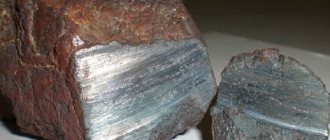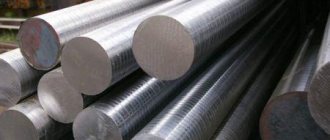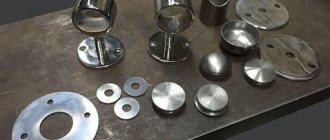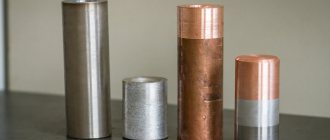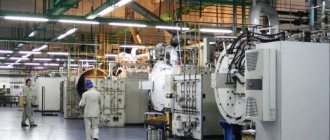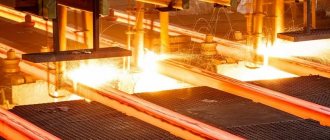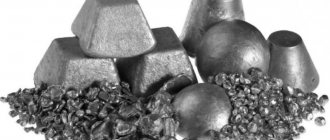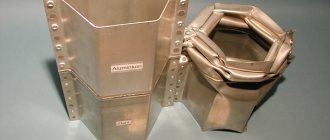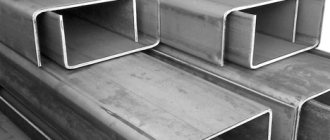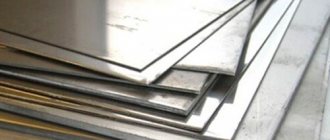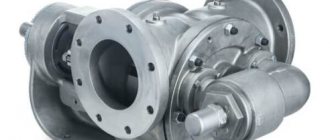Features of the material
There is a big difference between steel and cast iron. To identify it, you need to familiarize yourself with the definitions and characteristics of metals.
Cast iron
Cast iron is made up of iron and carbon. In this case, the amount of the second component should be more than 2%. Raw materials are doped with various additives. These include silicon, phosphorus, manganese and other substances.
Depending on the crystal lattice formed, there are the following types of cast iron:
- White - the name is due to the shade of the fractured material. It is associated with the presence of cementite in the composition. In addition to hardness, the material is brittle. By annealing it is used to produce malleable cast iron.
- Gray - the shade of the raw material is due to the high graphite content. The material is distinguished by its plasticity and ease of processing. The composition contains sulfur, phosphorus, magnesium and silicon.
- Malleable – Prolonged annealing of white cast iron results in the formation of graphite. This substance makes the metal very ductile, viscous and hard. In addition, it gives it good impact resistance.
- High strength - the formation of spherical graphite during crystallization provides the substance with a high degree of strength.
- Ultimate – subject to further processing. It cannot be used as an independent unit.
The melting point of this metal is at the level of 1160-1250 degrees. The specific value is determined by the carbon content. The more substance in the composition, the lower its temperature and the greater the fluidity when heated. This dependence is associated with the fragility of the substance.
Steel
This material contains 45% iron and 2% carbon. Depending on the grade, steel may contain additional substances. These include chromium, nickel, manganese, silicon and others. Depending on the alloying components, the properties of the material also change.
Carbon provides the material with hardness and strength properties. Thanks to the presence of this substance, the material is durable and flexible. It is quite easy to handle.
Depending on the content of alloying substances, steel can have the following varieties:
- low alloy;
- medium alloyed;
- highly alloyed.
Depending on the carbon content, there are the following types of steel:
- low carbon;
- medium carbon;
- high carbon.
The melting point of all brands is 1450-1520 degrees. Density parameters are at the level of 7700-7900 kilograms per 1 cubic meter.
Steel has a wide range of applications. It is used in industry in the manufacture of various types of metal structures, machine elements, pipelines and other products. In everyday life, people use interior items, dishes, and furniture made of steel.
Iron
Pure iron can only be found in laboratory conditions. In addition, it cannot be used for mass production of spare parts, plumbing fixtures or household items. Unlike cast iron, iron has a light silver tint, softness and ductility. In addition, it is highly susceptible to corrosion.
Expert opinion
Karnaukh Ekaterina Vladimirovna
Graduated from the National University of Shipbuilding, majoring in Enterprise Economics
It is important not to confuse iron with steel, which is its derivative. These concepts cannot be considered interchangeable. Steel is an alloy of iron with a small amount of additives. Sulfur, phosphorus, silicon, manganese, and carbon are used as additional components. The resulting iron-carbon alloy is elastic. It is malleable and deformable.
Alloy steels
The table for decoding steels by composition is presented below.
| Designation | Chem. element | Name | Designation | Chem. element | Name |
| X | Cr | Chromium | A | N | Nitrogen |
| WITH | Si | Silicon | N | Ni | Nickel |
| T | Ti | Titanium | TO | Co | Cobalt |
| D | Cu | Copper | M | Mo | Molybdenum |
| IN | Wo | Tungsten | B | Nb | Niobium |
| G | Mn | Manganese | E | Se | Selenium |
| F | W | Vanadium | C | Zr | Zirconium |
| R | B | Bor | YU | Al | Aluminum |
If the name contains the letter “H”, then the alloying elements include rare earth elements - niobium, lanthanum, cerium.
Cerium (Ce) – affects strength characteristics and ductility.
Lanthanum (La) and neodymium (Ne) - reduce the sulfur content and reduce the porosity of the metal, leading to a decrease in grain size.
How are they different?
Carbon components give the molecular structure strength and hardness. At the same time, the fragility of products increases under heating, shock and vibration loads. Plastic material easily withstands these types of impacts.
The main difference between cast iron and steel is the carbon content. Alloys can be alloyed with the same metals. However, the results are different. This is due to differences in the carbide lattices.
Composition and microstructure
When making steel, iron, carbon and impurities are combined. Moreover, the amount of carbon in the composition should be no more than 2%, and the iron content should be no less than 45%. The remaining percentage comes from alloying substances - they are used to bind the mixture. Such components include chromium, nickel, and molybdenum.
Due to the presence of carbon, iron becomes more durable and acquires the required hardness. Without it, the mass would turn out viscous and plastic.
Cast iron is also made from iron and carbon. However, the amount of the second component in the mixture exceeds 2%. In addition, permanent impurities are also introduced into the cast iron. These include phosphorus, sulfur, silicon, manganese, as well as alloying substances.
Production
In production conditions, the type of metal can be determined in the following ways:
- By fracture - this visual method is used for parts that are scrapped or used as blanks. A matte dark gray color is noticeable on scrap cast iron. In this case, the cracks that form have a pronounced structure. Steel products are lighter and have a glossy surface.
- Drilling – steel shavings have a twisted shape. It is longer than the drill and bends easily. Cast iron shavings crumble even with slight impact.
- Grinding - as a result of the passage of a grinding machine, the steel surface is covered with a large number of yellow and white sparks. Cast iron has fewer sparks. In addition, they are shorter and have a reddish tint.
Characteristics
It is possible to identify differences between workpieces that can be processed by visual signs. On scrapped cast iron products, a dark gray tint with a matte surface is visible. At the same time, the steel has a lighter color and glossy texture.
The appearance of the metal is influenced by the amount of carbon components. They can be distinguished by the type of cracks. High-carbon steel surfaces are characterized by defects in the form of splitting. If the product is made of a low-carbon alloy, the cracks resemble a plastic break.
Differences between metals also lie in technical characteristics. Steel has the following properties:
- density – 7700-7900 kilograms per 1 cubic meter;
- melting point – 1450-1520 degrees;
- strength, wear resistance, hardness;
- resistance to deformation;
- high ductility - this helps to process metal in different ways;
- the possibility of improving the quality of the material through hardening;
- the possibility of improving the properties of the alloy by introducing alloying additives.
Cast iron is also an alloy of iron and carbon. However, the content of the second component is higher. The same applies to additional components. Therefore, cast iron is considered a more fragile material - it breaks easily.
The melting point of cast iron depends on the carbon content. As the volume of this component increases, the temperature decreases. In addition, there is an increase in fluidity when heated. This does not have the best effect on the performance properties - fragility, ductility, ease of processing. The melting point of cast iron is 1160-1250 degrees.
Strength
Steel is stronger compared to cast iron. It is stronger due to its structure. The increased carbon content in cast iron makes it more brittle and less ductile.
Carbon content
Steel differs from cast iron in carbon content. The amount of this component in the metal does not exceed 2%. Cast iron typically has a carbon volume greater than 2.14% but less than 4.5%.
Scope of application
Cast iron is considered a casting material. It is used to make simple dishes, machine bodies, and massive pipes. Large objects of simple configuration are also made from metal. Parts of different sizes and complexity are made from steel, since forging, drawing, stamping, and rolling are used for this. It is also permissible to use other processing methods for this metal.
Expert opinion
Karnaukh Ekaterina Vladimirovna
Graduated from the National University of Shipbuilding, majoring in Enterprise Economics
If the question arises what the reinforcement is made of, there is no doubt - it is steel. If you are interested in the composition of a large cauldron, you can say with confidence that it is made of cast iron. In this case, the engine housing or crankshaft can be made of any metal. Therefore, in this case, you need to resort to recognition methods.
Iron production
Cast iron is smelted in blast furnaces. This is a complex engineering structure that operates continuously for 5..10 years.
The oven operates on the counterflow principle. Ore, fluxes and coke are loaded from above, and air is supplied from below. Coke serves to heat and melt ore, and also participates in the reduction of iron from ore oxides. Coke should contain a minimum of sulfur and phosphorus. Fluxes (limestones, silicas) are necessary for the production of slags. When fuel is burned, carbon monoxide is formed, which is the main reducing agent for iron.
Pros and cons of each metal
Alloys have certain advantages and disadvantages. The advantages of steel include the following:
- high margin of strength and hardness;
- a large number of properties - this is due to different options for alloying impurities;
- optimal ratio of elasticity and viscosity - the material perfectly withstands static, dynamic and shock loads;
- ease of processing;
- high margin of safety - due to this, the material has a long service life;
- simplicity and affordable cost of casting.
However, the material also has a number of disadvantages:
- poor corrosion resistance - this applies to pure types of steel that do not contain alloying components;
- high electromechanical corrosion - this is due to the property of storing electrical energy;
- heavy weight of steel structures;
- high risk of defects - this is due to the multi-stage manufacturing process.
Cast iron has the following advantages:
- high level of strength - some brands are comparable in this parameter to steel;
- uniform heat distribution and the possibility of long-term preservation;
- safe composition - this allows the use of cast iron for making cookware;
- resistance to acids and alkalis;
- high degree of hygiene;
- durability.
However, metal also has some disadvantages:
- risk of corrosion processes due to prolonged exposure to water;
- lack of ductility of gray cast iron;
- increased fragility of white material.
Decoding steels: examples
For an example of decoding, consider the common steel grade 12Х18Н10Т.
The number “12” at the beginning of the brand name is an indicator of the carbon content in this steel; it does not exceed 0.12%. Next comes the designation “X18” - therefore, the steel contains the element chromium in an amount of 18%. The abbreviation “H10” indicates the presence of nickel in a volume of 10%. The letter “T” indicates the presence of titanium, the absence of a digital expression means that it is less than 1.5%. Obviously, a qualified decoding of steel by composition immediately gives an idea of its quality characteristics.
If we compare the designations of alloy and carbon steels, this becomes a noticeable difference, indicating the special properties of the metal due to specially introduced alloying additives. Decoding steels and alloys indicates their chemical composition. The main alloying additives are:
- nickel (Ni) – reduces chemical reactivity and improves the hardenability of the metal;
- chromium (Cr) – increases the tensile strength and yield strength of alloys;
- niobium (Nb) – increases acid resistance and corrosion resistance of welded joints;
- cobalt (Co) – increases heat resistance and impact strength.
Quick comparison table
The main differences between metals are briefly presented in the table:
| Steel | Cast iron |
| Has high strength and hardness. | It is considered a more fragile and less ductile material. |
| Has a higher melting point. | Differs in lower melting temperatures. |
| Contains less than 2% carbon. | Includes more than 2% carbon. |
| It is less porous and has greater thermal conductivity. | Contains more pores and is characterized by lower thermal conductivity. |
| It has a light shade and shiny surface. | It is distinguished by its dark color and matte surface. |
| Has a higher cost. | It costs less. |
Positive aspects of doping
The peculiarities of the properties are most clearly manifested after heat treatment; therefore, all parts made of such steel are processed before use.
- Steels and alloys improved by alloying have higher mechanical properties compared to structural ones.
- Alloying additives help stabilize austenite, improving the hardenability of steels.
- Due to the reduced degree of austenite decomposition, the formation of quenching cracks and warping of parts is reduced.
- Impact strength increases, which leads to a decrease in cold brittleness, and parts made of alloy steels have higher durability.
Negative sides
Along with the positive aspects, steel alloying also has a number of characteristic disadvantages. These include the following:
- In products made from alloy steels, reversible temper brittleness of the second type is observed.
- High-alloy class alloys include retained austenite, which reduces hardness and fatigue resistance.
- Tendency to form dendritic segregations, which leads to the appearance of stitch structures after rolling or forging. To eliminate the effect, diffusion tempering is used.
- Such steels are prone to flake formation.
Melting temperatures of steel
Under certain conditions, solids melt, that is, they turn into a liquid state. Each substance does this at a certain temperature.
- Melting is the process of transition of a substance from a solid to a liquid state.
- Melting point is the temperature at which a crystalline solid melts into a liquid state. Denoted by t.
Physicists use a specific table of melting and crystallization, which is given below:
| Substance | t,°C | Substance | t,°C | Substance | t,°C |
| Aluminum | 660 | Copper | 1087 | Alcohol | — 115 |
| Voden | — 256 | Naphthalene | 80 | Cast iron | 1200 |
| Tungsten | 3387 | Tin | 232 | Steel | 1400 |
| Iron | 1535 | Paraffin | 55 | Titanium | 1660 |
| Gold | 1065 | Mercury | — 39 | Zinc | 420 |
Based on the table, we can safely say that the melting point of steel is 1400 °C.
